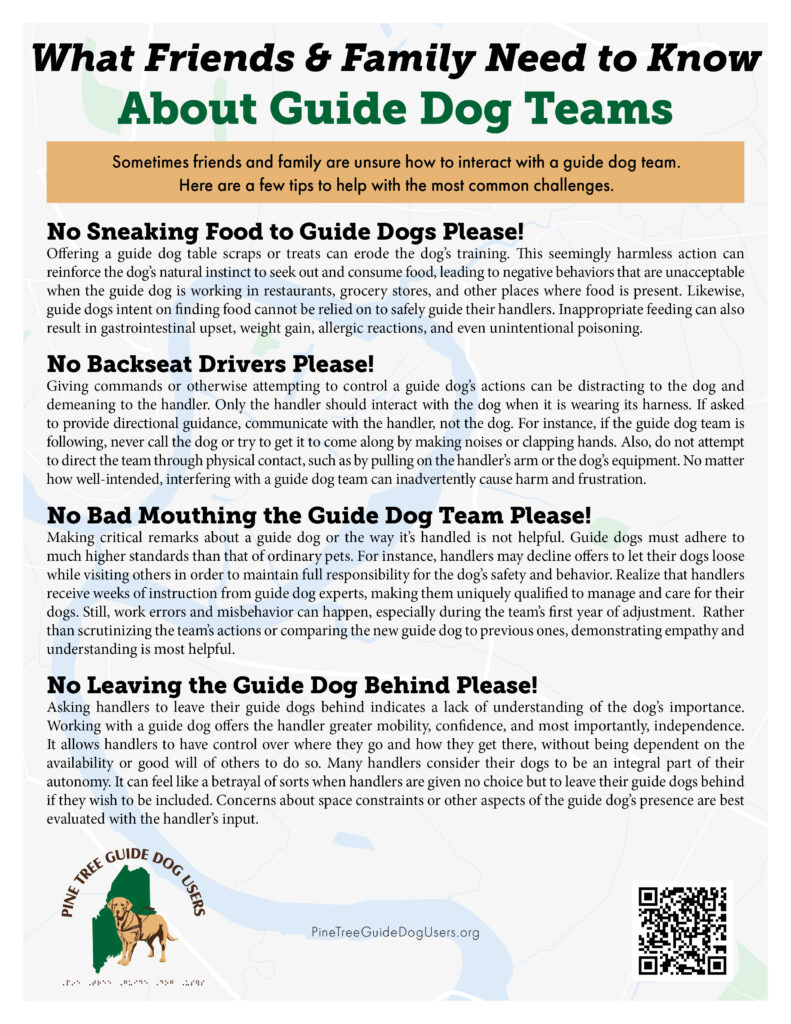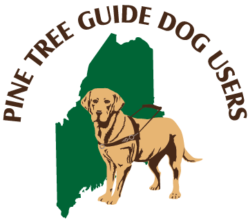Sometimes friends and family are unsure how to interact with a guide dog team. Here are a few tips to help with the most common challenges.

No Sneaking Food to Guide Dogs Please!
Offering a guide dog table scraps or treats can erode the dog’s training. This seemingly harmless action can reinforce the dog’s natural instinct to seek out and consume food, leading to negative behaviors that are unacceptable when the guide dog is working in restaurants, grocery stores, and other places where food is present. Likewise, guide dogs intent on finding food cannot be relied on to safely guide their handlers. Inappropriate feeding can also result in gastrointestinal upset, weight gain, allergic reactions, and even unintentional poisoning.
No Backseat Drivers Please!
Giving commands or otherwise attempting to control a guide dog’s actions can be distracting to the dog and demeaning to the handler. Only the handler should interact with the dog when it is wearing its harness. If asked to provide directional guidance, communicate with the handler, not the dog. For instance, if the guide dog team is following, never call the dog or try to get it to come along by making noises or clapping hands. Also, do not attempt to direct the team through physical contact, such as by pulling on the handler’s arm or the dog’s equipment. No matter how well-intended, interfering with a guide dog team can inadvertently cause harm and frustration.
No Bad Mouthing the Guide Dog Team Please!
Making critical remarks about a guide dog or the way it’s handled is not helpful. Guide dogs must adhere to much higher standards than that of ordinary pets. For instance, handlers may decline offers to let their dogs loose while visiting others in order to maintain full responsibility for the dog’s safety and behavior. Realize that handlers receive weeks of instruction from guide dog experts, making them uniquely qualified to manage and care for their dogs. Still, work errors and misbehavior can happen, especially during the team’s first year of adjustment. Rather than scrutinizing the team’s actions or comparing the new guide dog to previous ones, demonstrating empathy and understanding is most helpful.
No Leaving the Guide Dog Behind Please!
Asking handlers to leave their guide dogs behind indicates a lack of understanding of the dog’s importance. Working with a guide dog offers the handler greater mobility, confidence, and most importantly, independence. It allows handlers to have control over where they go and how they get there, without being dependent on the availability or good will of others to do so. Many handlers consider their dogs to be an integral part of their autonomy. It can feel like a betrayal of sorts when handlers are given no choice but to leave their guide dogs behind if they wish to be included. Concerns about space constraints or other aspects of the guide dog’s presence are best evaluated with the handler’s input.
Download Our Flyer
Download and print the PDF version of this tip sheet for friends and family (portrait format).
